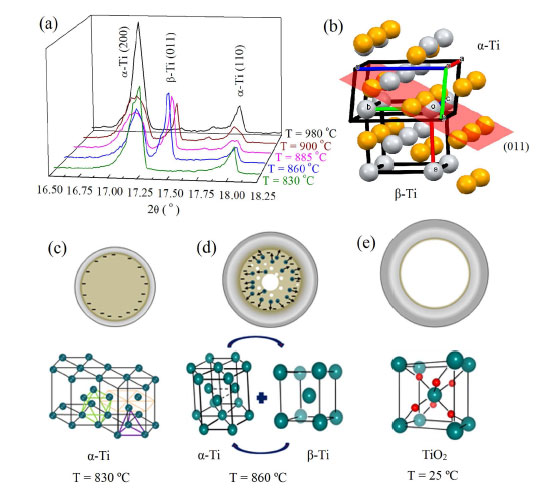PeNSeM publishes important results in Nature Scientific Reports.
Hollow micro/nano structures form an important family of functional materials. We have used the thermal oxidation process combined with the passage of electric current during a structural phase transition to disclose a colossal mass diffusion transfer of Ti ions. This combination points to a new route for fabrication of hollow materials. A structural phase transition at high temperature prepares the stage by giving mobility to Ti ions and releasing vacancies to the system. The electric current then drives an inward delocalization of vacancies, condensing into voids, and finally turning into a big hollow. This strong physical phenomenon leading to a colossal mass transfer through ionic diffusion is suggested to be driven by a combination of phase transition and electrical current followed by chemical reaction. We show this phenomenon for Ti leading to TiO2 microtube formation, but we believe that it can be used to other metals undergoing structural phase transition at high temperatures.
The precise details of how the electric current and the structural phase transition combine to yield this mass transfer mechanism are not entirely understood. Notwithstanding, some possibilities may be elucidated. It is recognized that during the phase transition, diffusive movement of ions to create the new structure takes place. In this case, from hexagonal to cubic, there is the diffusion and dislocation of atoms lying on plane (011) of the former phase (orange spheres) to the plane (011) of the latter one (grey spheres). One can see the atoms located at the middle of the α-Ti will move towards the corners of the β-Ti phase. Diffusion of substitutional lattice atoms involves a large number of defects creating vacancies. Delocalization of vacancies will bring about the formation of void within the low temperature phase. A er vacancies condensation, voids may coalesce into a single larger hollow core. It is interesting that close-packed lattice (α-Ti) contains small holes in its structure, which account for 26% of the total crystal volume. In this case, there are octahedral and tetrahedral holes as illustrated. We believe that the phase transformation/retransformation dynamic releases even more vacancies and increases Ti ions mobility.
Without electrical current, the Kirkendall effect may occur on Ti/TiO2 interface leading to the formation of vacancies, but the voids are much smaller than the microscale of the pores due to poor vacancy mobility and, con- sequently, the tubular morphology is not observed. In a metallic conductor, the applied current would concentrate more on the surface of the microwire creating an electric field. e onset of a structural phase transition creates a huge amount of vacancies due to diffusion of ions in order to form another phase with a body-centered cubic crystal structure. e alteration of the atomic arrangement accompanied by dislocation of planes and bond shortening can induce strain localization between the low and high temperature crystal phase achieving movement and agglomeration of vacancies. e application of electrical current would lead to a high degree of mobility, delocalizing the vacancies, pulling them to the center, and form- ing huge voids. A er the formation of voids, the ow of Ti ions would be through surface and lattice diffusion. In this case, we believe that the electrical current would also accelerate the diffusion process in order to consume the entire metallic core in a very narrow temperature interval and time. Extensive studies on the influence of electric eld during oxidation were performed by Fromhold. More recently, a self-consistent and quantitative under- standing of the electric eld role in the growing oxide lm during oxidation process is presented. However, the colossal diffusion phenomenon shown here has never been observed and not taken into account on these studies. It is well accepted that there is an electrostatic potential drop across the oxide layer, but quantitative understand- ing of the role of electric eld remains incipient.
The study presented here reveal two major results in condensed matter physics. First, a colossal mass transfer physical phenomenon where the scenario combines structural phase transition, electrical current, and oxidation process at high temperatures. Second, as a consequence of mass transfer, a new route for hollow materials is anticipated. We believe that this new, simple, fast, and reproducible synthesis method to produce TiO2 microtubes can be extended to other metals showing structural phase transition at high temperature. We have repeated the above experiments using Cu, Ni, and Fe, exploring them under diverse temperature and cur- rent conditions. With the sole exception of Fe, which shows a structural phase transition at 912 °C from gamma to alpha phase, in no other case were we able to reproduce the results obtained here for Ti. e result reveals the importance of phase transition in the process. We consider that microtubes of other metals showing structural phase transition at high temperature can also be obtained. We believe that this study opens a novel avenue for both fundamental physics related to solid state di usion and material science where design of hollow materials with potential smart functionalities can be obtained. So far, an envisaged analytical expression for the ux of ions involving electrical current which cause colossal mass transfer is not available and it is beyond the scope of this work. We hope that these results attract the attention of scientist interested in elucidating the microscopic mech- anism leading to this colossal ions di usion e ect.
Leia na integra o artigo New route for hollow Materials


